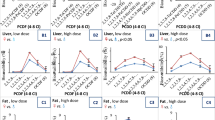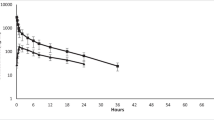Abstract
A defined mixture of polychlorinated dibenzo-p-dioxins and dibenzofurans (PCDDs and PCDFs) was subcutaneously administered to marmoset monkeys (Callithrix jacchus). Tissue concentrations in hepatic and adipose tissue were measured at different times after treatment (1–28 weeks). One week after application high concentrations could be detected for the 2,3,7,8-substituted congeners only. The percent of the administered dose in whole liver differed for the various 2,3,7,8-substituted congeners, ranging from 24.5±4.5% for 2,3,7,8-TCDD to 74.1±4.9% for 2,3,4,6,7,8-H6CDF. Therefore, the concentration ratio (liver/adipose tissue) was also very different, ranging from about 1 (2,3,7,8-T4CDD or 2,3,7,8-T4CDF) to >10 in the case of some higher chlorinated PCDDs and PCDFs. Half-lives of PCDDs and PCDFs were very different for the various 2,3,7,8-substituted congeners. For the most toxic compound (2,3,7,8-T4CDD) a t/2 of about 8 weeks in hepatic tissue and about 11 weeks in adipose tissue was found when calculated from data obtained later than 6 weeks after injection. For 2,3,7,8-T4CDD and 1,2,3,7,8-P5CDD the decreases in hepatic concentrations were much faster during the first 6 weeks after administration (t/2 of 4 weeks). This was apparently due to redistribution phenomena. Half-life increased with increasing degrees of chlorination. In some cases (e.g. OCDD, OCDF) no significant decrease in tissue concentrations could be observed after 28 weeks. The shortest t/2 was determined for 2,3,7,8-T4CDF: shorter than 6 days in hepatic tissue and about 10 days in adipose tissue. Calculation of the body burden of thenon-2,3,7,8-substituted PCDDs/PCDFs 1 week after injection revealed that all groups of isomers were present at less than 5%. Consequences of these findings for the use of TCDD-toxic-equivalency factors are discussed and a change in strategy is suggested.
Similar content being viewed by others
Abbreviations
- PCDDs/PCDFs:
-
polychlorinated dibenzo-p-dioxins and dibenzofurans
- T4CDDs/T4CDFs:
-
tetra-chlorinated dibenzo-p-dioxins and dibenzofurans
- P5CDDs/P5CDFs:
-
penta-chlorinated dibenzo-p-dioxins and dibenzofurans
- H6CDDs/H6CDFs:
-
hexa-chlorinated dibenzo-p-dioxins and dibenzofurans
- H7CDDs/H7CDFs:
-
hepta-chlorinated dibenzo-p-dioxins and dibenzofurans
- OCDD/OCDF:
-
octa-chlorinated dibenzo-p-dioxin and dibenzofuran
- DMSO:
-
dimethylsulfoxide
- TE-factor:
-
Toxic equivalency factor, used for risk assessment, is assumed to compare the toxicity of the congener with that of 2,3,7,8-T4CDD (toxicity = 1)
References
Abraham K, Krowke R, Neubert D (1988) Pharmacokinetics and biological activity of 2,3,7,8-tetrachlorodibenzo-p-dioxin: 1. Dose-dependent tissue distribution and induction of hepatic ethoxyresorufin O-deethylase in rats following a single injection. Arch Toxicol 62: 359–368
Abraham K, Krowke R, Neubert D (1989a) Absorption of TCDD following parenteral application in rats using various vehicles. Chemosphere 19: 893–898
Abraham K, Weberruß U, Wiesmüller T, Hagenmaier H, Krowke R, Neubert D (1989b) Comparative studies on absorption and distribution in the liver and adipose tissue of PCDDs and PCDFs in rats and marmoset monkeys. Chemosphere 19: 887–892
Abraham K, Wiesmüller T, Brunner H, Krowke R, Hagenmaier H, Neubert D (1989c) Absorption and tissue distribution of various polychlorinated dibenzo-p-dioxins and dibenzofurans (PCDDs and PCDFs) in the rat. Arch Toxicol 63: 193–202
Abraham K, Wiesmüller T, Brunner H, Krowke R, Hagenmaier H, Neubert D (1989d) Elimination of various polychlorinated dibenzo-p-dioxins and dibenzofurans (PCDDs and PCDFs) in rat faeces. Arch Toxicol 63: 75–78
Beck H, Eckart K, Mathar W, Wittkowski R (1987) Isomerenspezifische Bestimmung von PCDD and PCDF in Human- und Lebensmittelproben. VDI Berichte 634: 359–382
Beck H, Eckart K, Mathar W, Wittkowski R (1989a) PCDD and PCDF body burden from food intake in the Federal Republic of Germany. Chemosphere 18: 417–424
Beck H, Eckart K, Mathar W, Wittkowski R (1989b) Levels of PCDDs and PCDFs in adipose tissue of occupationally exposed workers. Chemosphere 18: 507–516
Birnbaum LS, Decad GM, Matthews HB, McConnell (1981) Fate of 2,3,7,8-tetrachlorodibenzofuran in the monkey. Toxicol Appl Pharmacol 57: 189–196
Brewster DW, Elwell MR, Birnbaum LS (1988) Toxicity and disposition of 2,3,4,7,8-pentachlorodibenzofuran in the Rhesus monkey (Macaca mulatta). Toxicol Appl Pharmacol 93: 231–246
Brunner H, Wiesmüller T, Hagenmaier H, Abraham K, Krowke R, Neubert D (1989) Distribution of PCDDs and PCDFs in rat tissues following various routes of administration. Chemosphere 19: 907–912
Decad GM, Birnbaum LS, Matthews HB (1982) Disposition of 2,3,7,8-tetrachlorodibenzofuran in guinea pigs, rats and monkeys. In: Hutzinger O, Frei RW, Merian E, Pocchiari F (eds) Chlorinated dioxins and related compounds, Pergamon Press, Oxford, New York, Toronto, pp 307–315
Fürst P, Krüger C, Meemken H-A, Groebel W (1989) PCDD and PCDF levels in human milk — dependence on the period of lactation. Chemosphere 18: 439–444
Hagenmaier H, Brunner H, Haag R, Kraft M (1987) Copper-catalyzed dechlorination/hydrogenation of polychlorinated dibenzo-p-dioxins, polychlorinated dibenzofurans, and other chlorinated aromatic compounds. Environ Sci Technol 21: 1085–1088
Hagenmaier H, Wiesmüller T, Golor G, Krowke R, Helge H, Neubert D (1990) Transfer of various polychlorinated dibenzo-p-dioxins and dibenzofurans (PCDDs and PCDFs) via placenta and through milk in a marmoset monkey. Arch Toxicol (in press)
Heger W, Merker HJ, Neubert D (1988) Frequency of prenatal loss in marmoset monkeys (Callithrix jacchus). In: Neubert D, Merker HJ, Hendrickx AG (eds) Non-human primates — developmental biology and toxicology. Ueberreuter Wissenschaftsverlag, Wien, Berlin, pp 129–140
Krowke R (1986) Studies on distribution and embryotoxicity of different PCDD and PCDF in mice and marmosets. Chemosphere 15: 2011–2022
Kuroki H, Masuda Y, Yoshihara S, Yoshimura H (1980) Accumulation of polychlorinated dibenzofurans in the livers of monkeys and rats. Food Cosmet Toxicol 18: 387–392
McNulty WP, Nielsen-Smith KA, Lay JO, Lippstreu DL, Kangas NL, Lyon PA, Gross ML (1982) Persistence of TCDD in monkey adipose tissue. Food Chem Toxicol 20: 985–986
Merker H-J, Heger W, Sames K, Stürje H, Neubert D (1988) Embryotoxic effects of thalidomide-derivates in the non-human primateCallithrix jacchus. I. Effects of 3-(1,3-dihydro-1-oxo-2H-isoindol-2-yl)-2,6-dioxopiperidine (EM 12) on skeletal development. Arch Toxicol 61: 165–179
NATO (1988) Pilot Study on International Information Exchange on Dioxins and Related Compounds. International toxicity equivalency factor (I-TEF). Method of risk assessment for Complex mixtures of dioxins and related compounds. NATO Report 176: 1–26
Needham LL, Patterson DG, Pirkle JL, Henderson LO, Burse VW (1989) The basis for measuring 2,3,7,8-tetrachlorodibenzo-p-dioxin in serum. Chemosphere 18: 425–430
Norback DH, Engblom JF, Allen JR (1975) Tissue distribution and excretion of octachlorodibenzo-p-dioxin in the rat. Toxicol Appl Pharmacol 32: 330–338
Poiger H, Schlatter C (1986) Pharmacokinetics of 2,3,7,8-TCDD in man. Chemosphere 15: 1489–1494
Poiger H, Pluess N, Schlatter C (1989) Subchronic toxicity of some chlorinated dibenzofurans in rats. Chemosphere 18: 265–275
Rappe C, Nygren M, Lindström G, Hansson M (1986) Dioxins and dibenzofurans in biological samples of European origin. Chemosphere 15: 1635–1639
Rose JQ, Ramsey JC, Wentzler TH, Hummel RA, Gehring PJ (1976) The fate of 2,3,7,8-tetrachlorodibenzo-p-dioxin following single and repeated oral doses to the rat. Toxicol Appl Pharmacol 36: 209–226
Ryan JJ (1986) Variation of dioxins and furans in human tissue. Chemosphere 15: 1585–1593
Schecter A, Fürst P, Krüger C, Meemken H-A, Groebel W, Constable JD (1989) Levels of polychlorinated dibenzofurans, dibenzodioxins, PCBs, DDT and DDE, hexachlorobenzene, dieldrin, hexachlorocyclohexanes and oxychlordane in human breast milk from the United States, Thailand, Vietnam and Germany. Chemosphere 18: 445–454
Suter-Hofmann M, Schlatter C (1989) Subchronic relay toxicity study with a mixture of polychlorinated dioxins (PCDDs) and polychlorinated furans (PCDFs). Chemosphere 18: 277–282
Thoma H, Mücke W, Kretschmer E (1989) Concentrations of PCDD and PCDF in human fat and liver samples. Chemosphere 18: 491–498
UBA, Umweltbundesamt (1985) Sachstand Dioxine, Berichte 5/85. Erich Schmidt Verlag, Berlin, p 264
Van den Berg M, Heeremans C, Meerman L, Veenhoven E, van Wijnen J, Olie K, Hutzinger O (1986) Some pharmacokinetic aspects of PCDDs and PCDFs in mammals after administration of a fly ash extract from a municipal incinerator. Chemosphere 15: 1477–1487
Van den Berg M, Bouwman C, Seinen W (1989a) Hepatic retention of PCDD and PCDF in C57B1/6 and DBA/2 mice. Chemosphere 19: 795–802
Van den Berg M, de Jongh J, Eckhart P, van der Wielen FWM (1989b) The elimination and absence of pharmacokinetic interaction of some polychlorinated dibenzofurans (PCDFs) in the liver of the rat Chemosphere 18: 665–675
Van Miller JP, Marlar RJ, Allen JR (1976) Tissue distribution and excretion of tritiated tetrachlorodibenzo-p-dioxin in non-human primates and rats. Food Cosmet Toxicol 14: 31–34
Wacker R, Poiger H, Schlatter C (1986) Pharmacokinetics and metabolism of 1,2,3,7,8-penta-chlorodibenzo-p-dioxin in the rat. Chemosphere 15: 1473–1476
Wiesmüller T (1990) Untersuchungen zur katalytischen Dechlorierung von Octachlordibenzo-p-dioxin und Octachlordibenzofuran und Anwendung der erhaltenen Gemische in toxikologischen Studien. Inaugural-Dissertation, Fakultät für Chemie und Pharmazie, Eberhard-Karls-Universität, Tübingen
Author information
Authors and Affiliations
Additional information
Data presented in this paper are part of the doctoral thesis of Thomas Wiesmüller submitted to the Fakultät für Chemie und Pharmazie, Eberhard-Karls-Universität, Tübingen
Rights and permissions
About this article
Cite this article
Neubert, D., Wiesmüller, T., Abraham, K. et al. Persistence of various polychlorinated dibenzo-p-dioxins and dibenzofurans (PCDDs and PCDFs) in hepatic and adipose tissue of marmoset monkeys. Arch Toxicol 64, 431–442 (1990). https://doi.org/10.1007/BF01977624
Received:
Revised:
Accepted:
Issue Date:
DOI: https://doi.org/10.1007/BF01977624




